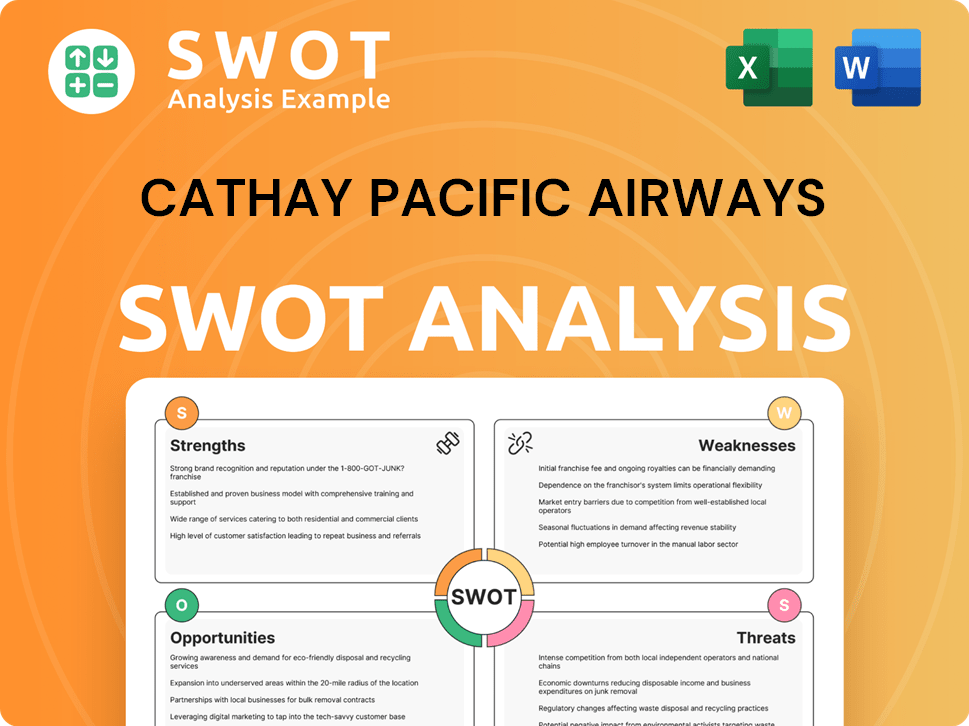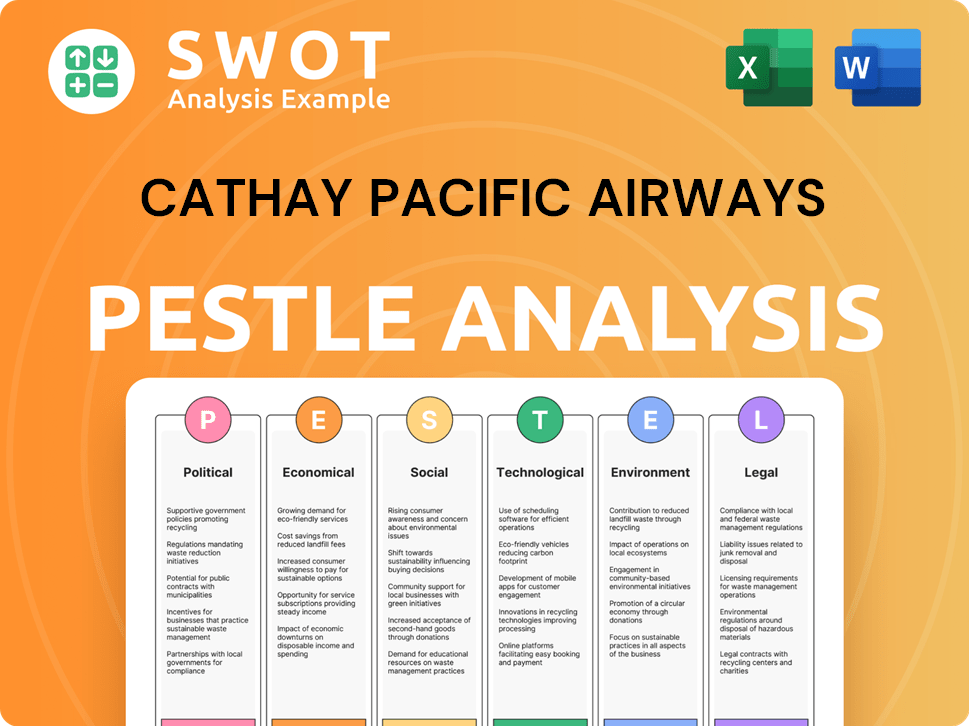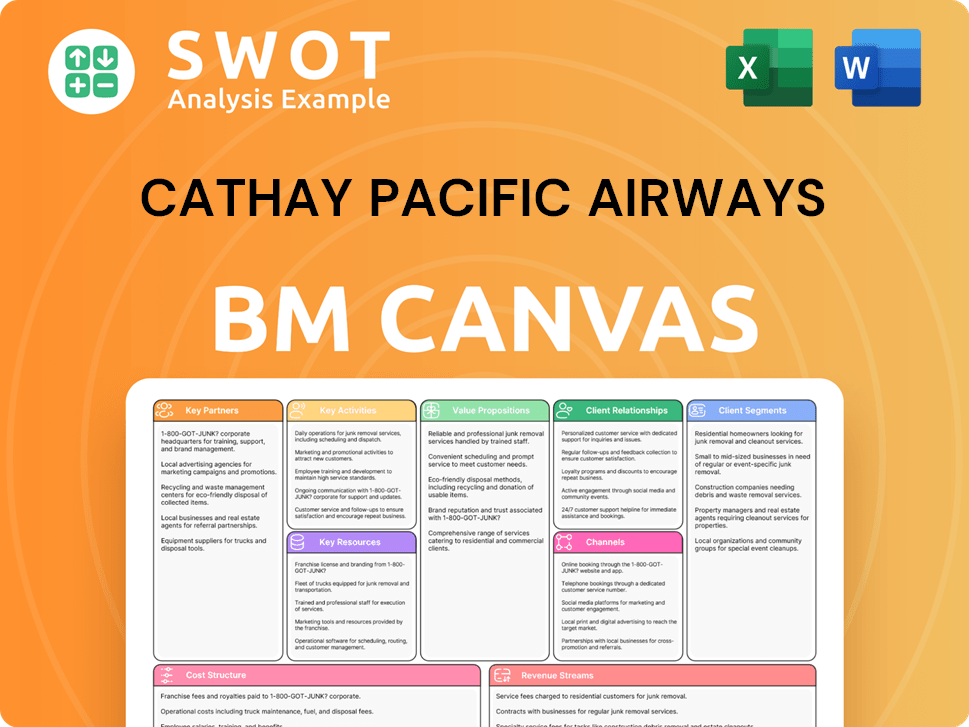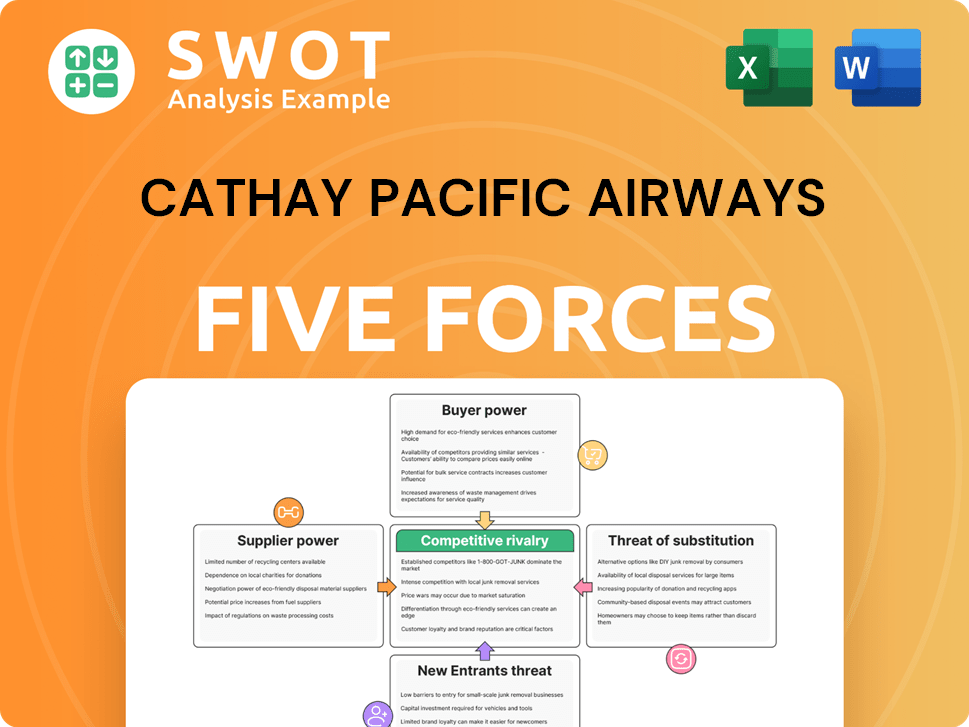Cathay Pacific Airways Bundle
What Drives Cathay Pacific Airways? Unveiling Its Core Principles
Discover the fundamental principles that guide Cathay Pacific Airways, a global leader in the aviation industry. Understanding the Cathay Pacific Airways SWOT Analysis is crucial, but first, let's explore the company's core identity.

Cathay Pacific's mission, vision, and core values are more than just words; they are the compass guiding its operations and strategic decisions. Explore how these elements shape its Airline strategy and contribute to its impressive financial performance, including a significant profit reported in 2024. Delving into Cathay Pacific's mission statement analysis and examining its Company values provides invaluable insights for investors and industry observers alike. Learn about Cathay Pacific's vision for the future and how it plans to achieve its strategic goals.
Key Takeaways
- Cathay Pacific's mission, vision, and values drive its strategy, emphasizing safety, service, and sustainability.
- The airline aims to be the 'world's most admired airline,' supported by investments in fleet, digital transformation, and network expansion.
- Strong financial performance and industry recognition validate the effectiveness of its guiding principles.
- Sustainability initiatives, like reducing carbon emissions, position Cathay Pacific as a leader in responsible business.
- Cathay Pacific's purpose extends beyond transport, focusing on connecting people and cultures responsibly.
Mission: What is Cathay Pacific Airways Mission Statement?
Cathay Pacific's mission is to deliver a premium travel experience, prioritizing safety, service, and sustainability, while inspiring customer loyalty, supporting employees, and contributing positively to Hong Kong.
Let's delve into the specifics of the Cathay Pacific mission and how it shapes the airline's operations and strategic direction.
The Cathay Pacific mission centers on three primary pillars: delivering a high-quality travel experience, ensuring operational excellence, and demonstrating a commitment to sustainability. These pillars are interconnected, with each element reinforcing the others to create a cohesive brand identity.
A key aspect of the Cathay Pacific mission is its customer-centric approach. The airline strives to inspire customer loyalty by consistently providing excellent service and exceeding expectations. This involves everything from in-flight comfort to seamless booking and check-in processes.
Operational excellence, particularly in safety, is paramount. Cathay Pacific invests heavily in maintenance, training, and technology to ensure the highest safety standards. The airline aims for a 99.9% on-time performance rate, reflecting its dedication to reliability.
Sustainability is a critical component of the Cathay Pacific mission. The airline is committed to achieving net-zero carbon emissions by 2050. Recent data shows a 30% reduction in carbon emissions per passenger kilometer compared to the 2019 baseline, demonstrating tangible progress.
The Company values extend to supporting employees and contributing to the Hong Kong community. This includes fostering a positive work environment and participating in initiatives that benefit the region. These aspects are integral to the Cathay Pacific's brand values.
Cathay Pacific actively translates its mission into concrete actions. For example, initiatives like expanding digital check-in services have achieved a 95% customer satisfaction rate. The airline's dedication to sustainable aviation fuel (SAF) further underscores its commitment to environmental responsibility. To learn more about their strategic approach, check out the Marketing Strategy of Cathay Pacific Airways.
Understanding the Cathay Pacific mission provides a foundation for analyzing the airline's Airline strategy and evaluating its performance. The mission statement guides decision-making, influences Cathay Pacific's strategic goals, and shapes the company's interactions with customers, employees, and the community. This focus on quality, safety, and sustainability positions Cathay Pacific for continued success in the competitive global aviation market.
Cathay Pacific Airways SWOT Analysis
- Complete SWOT Breakdown
- Fully Customizable
- Editable in Excel & Word
- Professional Formatting
- Investor-Ready Format

Vision: What is Cathay Pacific Airways Vision Statement?
Cathay Pacific's vision is to be the world's most admired airline, providing the finest travel experience, and leading the aviation industry through innovation, sustainability, and exceptional customer service.
Cathay Pacific's vision statement is a forward-looking declaration that emphasizes a commitment to excellence and leadership within the global aviation industry. This vision goes beyond simply transporting passengers; it focuses on creating a superior travel experience, fostering operational efficiency, and driving innovation. The airline's ambition is to be recognized as the best in the world, setting new standards for customer satisfaction, sustainability, and overall performance. Understanding the Cathay Pacific vision is crucial for grasping the company's long-term strategic goals.
The vision is distinctly future-oriented, aiming for global market leadership. Cathay Pacific strives to excel in everything they do, embracing accessibility, diversity, and inclusion. They prioritize the safety and well-being of their people and customers.
The scope of the vision is comprehensive, encompassing industry disruption through innovation, global impact through expanded connectivity, and market leadership through unparalleled customer satisfaction. The airline's strategic goals are ambitious and far-reaching.
Cathay Pacific is investing heavily in digital transformation, with a forecasted $1 billion allocated by 2025. They plan to add 10 new destinations by the end of 2024, projecting an additional $500 million in annual earnings. This expansion significantly expands its global footprint.
The airline demonstrated a strong financial recovery, with a net profit of HK$9.9 billion in 2024. Passenger volumes have also increased dramatically, reaching 25 million in 2023, up from 4 million in 2021, showing a clear path towards achieving its vision.
Cathay Pacific is committed to sustainability, aiming to reduce carbon emissions by 50% by 2030. In 2023, the airline achieved a 3.5 million ton CO2 reduction, demonstrating its commitment to environmental responsibility.
The airline is dedicated to improving staff satisfaction, targeting a 25% increase through a new employee engagement program in 2024. A $50 million budget is allocated for employee development over the next three years, aligning with its vision of excellence.
The Cathay Pacific vision is supported by tangible progress and strategic investments. The company's focus on innovation, sustainability, and customer satisfaction is evident in its financial performance, operational improvements, and employee engagement initiatives. The airline's ability to reach 100% of its pre-pandemic flight capacity by January 2025, operating services to over 100 destinations worldwide, further validates its ambitious goals. These efforts are crucial in a competitive market, as highlighted in the Competitors Landscape of Cathay Pacific Airways. The airline's commitment to its core values, including accessibility, diversity, and inclusion, is integral to its vision of becoming the world's most admired airline. The ongoing investment in fleet modernization, customer service enhancements, and sustainability initiatives, such as reducing carbon emissions by 50% by 2030 and a 3.5 million ton CO2 reduction in 2023, further demonstrate a clear path towards achieving this ambitious vision. This vision reflects the company's commitment to long-term success and its dedication to setting new benchmarks in the aviation industry. Understanding the Cathay Pacific's mission and Cathay Pacific core values is essential for a comprehensive understanding of the company's strategy.
Cathay Pacific Airways PESTLE Analysis
- Covers All 6 PESTLE Categories
- No Research Needed – Save Hours of Work
- Built by Experts, Trusted by Consultants
- Instant Download, Ready to Use
- 100% Editable, Fully Customizable

Values: What is Cathay Pacific Airways Core Values Statement?
Understanding the core values of Cathay Pacific is crucial to grasping the airline's identity and its approach to business. These values shape the company's culture, guide its decisions, and define its interactions with customers, employees, and stakeholders.
Cathay Pacific emphasizes treating everyone with respect and care, from customers to colleagues. This commitment is reflected in personalized services, such as new cabin products rolling out through 2026, and a strong focus on employee well-being, evidenced by an 85% workplace culture approval rating in 2024.
Inspired by its dynamic home in Hong Kong, Cathay Pacific embraces modern ideas and technology to improve the customer experience. This is demonstrated through a $1 billion investment in digital transformation by 2025 and the adoption of sustainable aviation fuel (SAF) since 2022, with a goal to reduce single-use plastics.
This value highlights Cathay Pacific's ability to overcome challenges with positivity and determination. Despite operational hurdles, the airline is expanding its network, aiming for over 100 destinations by 2025, and has demonstrated financial resilience, achieving a net profit of HK$9.9 billion in 2024.
Cathay Pacific is dedicated to environmental responsibility, as seen in its adoption of sustainable aviation fuel (SAF) since 2022 and its target to decrease passenger-facing single-use plastic items from an average of 7.7 pieces per passenger in 2019 to 1.5 pieces by 2025. This commitment is a key aspect of its progressive approach.
These core values—Thoughtful, Progressive, and Can-do—are integral to Cathay Pacific's identity and drive its strategic objectives. They are evident in the airline's commitment to customer service, technological innovation, and operational resilience. To further understand the company's direction, explore how its brand values influence its strategic decisions.
How Mission & Vision Influence Cathay Pacific Airways Business?
The Cathay Pacific mission and Cathay Pacific vision are not merely aspirational statements; they are the very foundation upon which the airline builds its strategic roadmap. These guiding principles directly shape the company's key decisions, influencing everything from product development to market expansion and sustainability initiatives.
Cathay Pacific's dedication to providing the 'finest travel experience' is clearly reflected in its substantial investments in product development. This commitment is evident in the multi-billion dollar fleet renewal program, with over 100 next-generation aircraft, including Airbus A321neo models, joining Cathay Pacific and HK Express by 2024. The introduction of the brand-new Business Class 'Aria Suite' in October 2024 and plans for new lounges in major hubs by 2026 further emphasize this dedication to premium service. The company's focus on customer satisfaction has paid off, as evidenced by Cathay Pacific being named one of the world's top three best airlines in 2025 by Skytrax, also winning World's Best Economy Class Airline and World's Best Inflight Entertainment.
- Fleet Renewal: Over 100 new aircraft by 2024.
- New Business Class: 'Aria Suite' launched in October 2024.
- Lounge Expansion: New lounges planned in major hubs by 2026.
- Awards: Named one of the world's top three best airlines in 2025 by Skytrax.
Driven by the Cathay Pacific vision of global leadership, the airline has aggressively pursued market expansion. By January 2025, Cathay Pacific had already reached 100% of its pre-pandemic flight capacity. The airline plans to operate passenger services to over 100 destinations worldwide within 2025. This expansion is projected to contribute an additional $500 million to the company's annual earnings. The Cathay Group aims for another 30% annual capacity gain in 2025, following a more than 30% year-on-year growth in available seat kilometers (ASK) in 2024. This strategic growth is a direct reflection of its airline strategy.
Aligned with its mission's focus on sustainability, Cathay Pacific has set ambitious targets to reduce carbon emissions. The airline aims to reduce carbon emissions by 50% by 2030 and achieve net-zero carbon emissions by 2050. In 2023, the airline reported a reduction of 3.5 million tons of CO2 emissions. Cathay Pacific has also significantly increased its Sustainable Aviation Fuel (SAF) usage, with a 22-fold increase in its Corporate SAF Programme compared to its launch in 2022, and is fostering a local SAF ecosystem in Hong Kong. These efforts have resulted in a 56% reduction of in-flight single-use plastic use, eliminating approximately 200 million single-use plastic articles annually. This demonstrates Cathay Pacific's commitment to sustainability.
The mission to 'respect and support each other to foster a productive and caring workplace' is a cornerstone of Cathay Pacific's company values. This is reflected in the airline's employee engagement initiatives. Cathay Pacific plans to implement a new employee engagement program in 2024, aiming to improve staff satisfaction by 25%, backed by a $50 million budget for employee development over the next three years. The company also announced bonuses of at least one month's salary for its employees in January 2025, reflecting its strong financial performance in 2024. This focus on employees is a key aspect of Cathay Pacific's core values.
Cathay Pacific's strong financial performance in 2024, with a reported net profit of $970 million, has enabled significant investments in future growth and customer experience enhancements, totaling over HK$100 billion. These investments are timed to coincide with the commencement of the Three-Runway System at Hong Kong International Airport, further solidifying the airline's strategic position. The airline's ability to execute its strategy is also influenced by the decisions made by the Owners & Shareholders of Cathay Pacific Airways.
CEO Ronald Lam has emphasized the importance of sustainability, stating, "Having successfully completed our two-year rebuilding journey, we have now set our sights on growth and development, where sustainability remains an area where we aspire to lead and is at the forefront of our path forward." This statement underscores how the Cathay Pacific mission and Cathay Pacific vision are integrated into every aspect of the business.
These statements shape day-to-day operations by embedding safety, service, and sustainability into every aspect of the business. The airline's commitment to its mission and vision is evident in its strategic decisions, from fleet renewal and market expansion to sustainability initiatives and workforce development. This commitment to its brand values is a key driver of its success.
In essence, the Cathay Pacific mission and Cathay Pacific vision are not just words; they are the guiding principles that shape the airline's strategic direction and influence its operational decisions. The consistent alignment of actions with these core tenets is crucial for the company’s long-term success. The next chapter will delve into the Core Improvements to Company's Mission and Vision.
Cathay Pacific Airways Business Model Canvas
- Complete 9-Block Business Model Canvas
- Effortlessly Communicate Your Business Strategy
- Investor-Ready BMC Format
- 100% Editable and Customizable
- Clear and Structured Layout

What Are Mission & Vision Improvements?
While Cathay Pacific's mission and vision statements currently serve their purpose, strategic refinements can enhance their relevance and competitiveness in today's dynamic aviation landscape. This analysis explores four key areas where the company can strengthen its mission and vision to better reflect its future direction and address emerging industry trends.
To stay ahead, Cathay Pacific's mission should explicitly emphasize hyper-personalization. This involves leveraging advanced technologies like AI and big data to create truly individualized customer journeys, going beyond simply 'enhancing customer experience.' The airline's investment of $1 billion in digital transformation by 2025 provides a strong foundation for this shift, which could be further enhanced by integrating predictive analytics for flight demand and personalized marketing campaigns.
Cathay Pacific's commitment to sustainability should be more deeply embedded within its core mission. Refining the mission to include phrases like 'pioneering sustainable aviation solutions' or 'leading the industry in responsible travel' would better reflect its ambitious net-zero by 2050 target and significant investments in Sustainable Aviation Fuel (SAF). This would elevate sustainability from a component to a central, differentiating purpose.
The vision statement should explicitly acknowledge resilience and adaptability as key aspirations, particularly given ongoing supply chain challenges and geopolitical shifts. Incorporating 'resilient global connectivity' or 'adaptive network leadership' into the vision would better reflect the dynamic external environment, especially impacting cargo operations, which accounted for 26.8% of Cathay Pacific's revenue in 2023.
Cathay Pacific's mission and vision should proactively address changing consumer behaviors, such as the increased demand for sustainable travel and seamless digital interactions. This includes adapting its mission and vision to address emerging technologies like advanced AI for predictive analytics and personalized marketing campaigns, as explored in detail in Growth Strategy of Cathay Pacific Airways.
How Does Cathay Pacific Airways Implement Corporate Strategy?
Effective implementation is crucial for translating a company's mission, vision, and core values into tangible results. This chapter examines how Cathay Pacific Airways actively integrates its guiding principles into its operations and strategic initiatives.
Cathay Pacific demonstrates its commitment to its mission and vision through significant investments in its fleet and cabin products.
- Fleet Renewal: The airline is undergoing a multi-billion dollar fleet renewal program, with over 100 new passenger and freighter aircraft expected in the coming years. This includes the introduction of the new Business Class 'Aria Suite' in October 2024, enhancing the passenger experience.
- Financial Performance: The company's strong financial performance in 2024, with a net profit of HK$9.9 billion, enabled it to commit over HK$100 billion to enhance customer experiences and sustain long-term growth.
Leadership plays a vital role in reinforcing the Cathay Pacific mission and vision. CEO Ronald Lam consistently emphasizes rebuilding, future growth, sustainability, and customer experience.
Cathay Pacific communicates its mission and vision to all stakeholders through various channels, fostering understanding and alignment.
In 2024, Cathay Pacific launched a new employee engagement program, aiming to improve staff satisfaction by 25%, and invested $50 million for employee development over the next three years.
Through its 2024 Sustainability Report, the airline transparently communicates its progress on environmental targets, such as reducing carbon emissions and single-use plastics, reinforcing its commitment to sustainability to customers and investors.
Cathay Pacific's core values are reflected in its business practices, ensuring alignment between its stated principles and actions.
- Safety and Reliability: Cathay Pacific aims for a 99.9% on-time performance rate in 2024, supported by investments in maintenance and operational protocols.
- Customer Commitment: The launch of the Cathay Pacific app in 2024 provides real-time flight updates, boarding passes, and baggage tracking, enhancing customer experience and efficiency.
- Environmental Responsibility: Cathay Pacific's partnership with HSBC Hong Kong and EcoCeres to support a local Sustainable Aviation Fuel (SAF) ecosystem and its co-founding of the Hong Kong Sustainable Aviation Fuel Coalition (HKSAFC) illustrate its proactive approach to its sustainability commitments.
Cathay Pacific utilizes formal programs and systems to reinforce its mission, vision, and core values.
The 'I Can Fly' youth development program, celebrating its 20th anniversary in 2024, fosters community engagement and aligns with the mission's aim to 'ensure Hong Kong is a better place with us.'
Ongoing digital transformation projects, with a forecasted budget of $1 billion by 2025, streamline operations and enhance the overall travel experience, supporting the vision of operational efficiency and innovation.
Cathay Pacific Airways Porter's Five Forces Analysis
- Covers All 5 Competitive Forces in Detail
- Structured for Consultants, Students, and Founders
- 100% Editable in Microsoft Word & Excel
- Instant Digital Download – Use Immediately
- Compatible with Mac & PC – Fully Unlocked

Related Blogs
- What are Mission Vision & Core Values of Cathay Pacific Airways Company?
- What is Competitive Landscape of Cathay Pacific Airways Company?
- What is Growth Strategy and Future Prospects of Cathay Pacific Airways Company?
- How Does Cathay Pacific Airways Company Work?
- What is Sales and Marketing Strategy of Cathay Pacific Airways Company?
- Who Owns Cathay Pacific Airways Company?
- What is Customer Demographics and Target Market of Cathay Pacific Airways Company?
Disclaimer
All information, articles, and product details provided on this website are for general informational and educational purposes only. We do not claim any ownership over, nor do we intend to infringe upon, any trademarks, copyrights, logos, brand names, or other intellectual property mentioned or depicted on this site. Such intellectual property remains the property of its respective owners, and any references here are made solely for identification or informational purposes, without implying any affiliation, endorsement, or partnership.
We make no representations or warranties, express or implied, regarding the accuracy, completeness, or suitability of any content or products presented. Nothing on this website should be construed as legal, tax, investment, financial, medical, or other professional advice. In addition, no part of this site—including articles or product references—constitutes a solicitation, recommendation, endorsement, advertisement, or offer to buy or sell any securities, franchises, or other financial instruments, particularly in jurisdictions where such activity would be unlawful.
All content is of a general nature and may not address the specific circumstances of any individual or entity. It is not a substitute for professional advice or services. Any actions you take based on the information provided here are strictly at your own risk. You accept full responsibility for any decisions or outcomes arising from your use of this website and agree to release us from any liability in connection with your use of, or reliance upon, the content or products found herein.